Search and rescue seaplane "Sin Maive" US-1 (Japan)
By the beginning of the seventies, the command of the Japanese Self-Defense Forces came to the conclusion that it was necessary to upgrade the search and rescue aircraft fleet. The existing Grumman UF-2 Albatross flying boats became obsolete morally and physically, and as a result, they would have to be written off in the foreseeable future. Solved this problem offered the easiest way. The company "Sin Maive" has already developed a new seaplane designed for use as part of anti-submarine defense. By a certain rework of the design and installation of new interior equipment, it could be a good replacement for the Albatross.
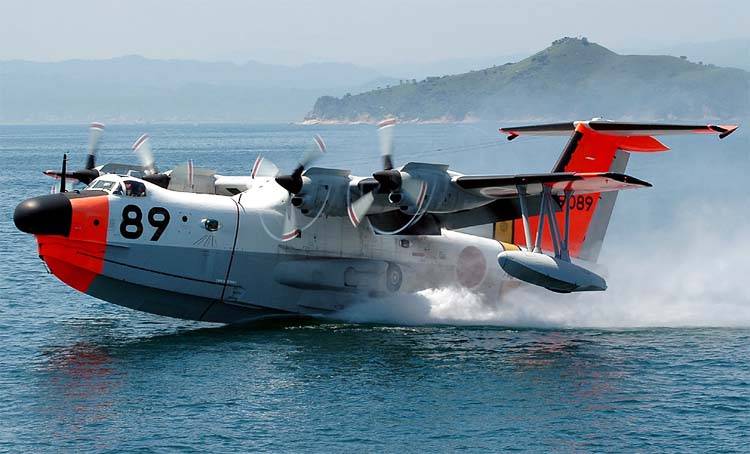
Seaplane US-1 on takeoff. Photo Airwar.ru
The development of a new search and rescue aircraft began in the middle of the 1970 year. The chief designer of the machine was Shizuo Kukihara, who previously led the creation of PS-1. The new project received the factory designation SS-2A, which defined it as a modification of the existing development. In addition, the name PS-1 “Kai” (“modernized”) was used. When adopting a new aircraft assigned another designation - US-1. From a certain time, the company-developer began production of US-1A production aircraft.
In accordance with the requirements of the customer, under the new project, the existing flying boat had to lose a number of systems, instead of which it was necessary to install new equipment. In addition, a certain reworking of the structure was required, aimed at simplifying operation in different conditions. The common features of the airframe, the composition of the power plant, the original control systems, etc. did not need serious alteration.
The technical assignment for the SS-2A / PS-1 “Kai” project provided for the removal of all armament and equipment to search for submarines. In a large cargo compartment it was necessary to equip places for accommodating sitting and lying injured, as well as for accompanying persons. On board was supposed to be a set of various equipment to perform rescue, from searchlights to search for victims at night to medical equipment. In addition, the customer wanted to get a universal machine capable of taking off not only from the water, but also from land airfields.
New technical task allowed to do without a radical processing of the existing design. For this reason, the new aircraft retained the architecture of a free-carrying all-metal high-profile with a turboprop main powerplant. The existing design of the hull-boat was kept. It was also proposed to reuse the used and tested boundary layer blowing system from control surfaces, for which an auxiliary power unit was required.
The future US-1 received all-metal fuselage characteristic shape, characterized by high altitude. The lower part of the fuselage was framed in the form of a boat of a unique design. Longitudinal protruding cheekbones, previously developed for PS-1, remained. The fuselage was distinguished by its simple layout. In the forward part, with an upward displacement, there was a crew cabin, next to which the instrument compartment was placed. The lower part of the hull-boats was given for the installation of some systems and components. All other volumes were cargo cabin. In the tail end of the cabin, on the left side, there was a large square hatch for working with large loads. In particular, with its help it was possible to launch an inflatable boat. As before, the habitable compartments were not sealed, which to a certain extent limited the height of the aircraft.
The wing of the two-spar scheme with a rectangular center section and trapezoid arms was retained. On the center section and consoles were placed four engine nacelles. Mechanization of the wing remained the same. On the leading edge there were movable slats, on the rear edge - two-section flaps and ailerons. It was also envisaged the use of spoilers on the upper surface of the wing. Between the planes, inside the characteristic fairing, there was an auxiliary power unit.
Near the tips under the wing was installed a pair of floats, necessary to improve the stability of the water. When entering land, they were at a safe distance from the surface.
The T-shaped tail assembly with a developed gargrot was used again. Swept keel carried the rudder, and on the trapezoid stabilizer were placed elevators. The tail rudders, as well as wing mechanization, were controlled using an irreversible hydraulic booster.
To improve manageability, especially at low speeds, the PS-1 and SS-2A projects provided for a boundary layer blowing system. Gas turbine engine General Electric T58 with HP 1360 power. using a piping system, applied compressed air to the flaps and elevators. Through the corresponding nozzles, the air was brought out to the surface of the planes, blowing the boundary layer and thereby increasing their efficiency.
The main propulsion system of the seaplane consisted of four turboprop engines General Electric T64-IHI-10E of American design, licensed by the Japanese company Ishikawjima-Harim. Engines developed power on 3060 HP each. However, such engines received only a few production cars. All other flying boats were completed with products T64-IHI-10J with power 3500 hp. Such a modification of the aircraft entered service under the designation US-1A. Both versions of the flying boat were completed with adjustable Hamilton Standard 63E-1 propellers with a diameter of 4,42 m.
The base plane "Sin Maive" PS-1 could take off only from the water. Operation on ground airfields was hampered by the insufficient strength of the chassis, which only allowed to descend or ascend along the slip, as well as perform simple maneuvers on the ground. In the new project, the chassis was noticeably enhanced. Now, a three-support system with a nose strut ensured takeoff and landing on standard lanes, thanks to which the aircraft became amphibious. In flight or on the water racks were cleaned in the fuselage niches.
The search radar AN / APS-80N was located in the nose fairing of the fuselage. Also onboard electronic equipment included a variety of communications, direction finders and other systems to search for victims. If necessary, the crew could even use high-powered searchlights, which made it easier to search in the dark. Visual observation could be carried out both with the help of a cockpit canopy and through hemispherical side windows.
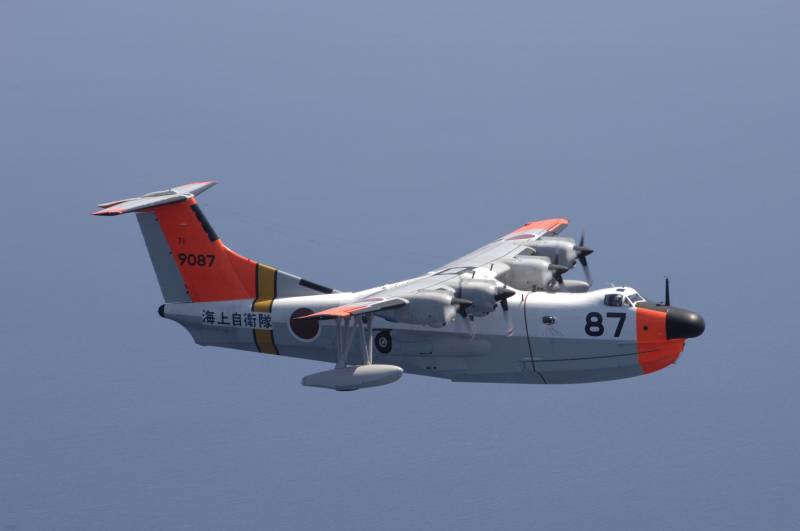
Seaplane in the air. You can consider the outlines of the bottom. Photo of the Ministry of Defense of Japan / mod.gov.jp
The cargo compartment was equipped with seating for the 20 passengers. If necessary, the aircraft could take and 36 affected. Corresponding mounts allowed the stretcher with recumbent wounded to be placed on the 12 board. The crew had medical and rescue equipment, medicines and first aid equipment, etc. It was assumed that during the rescue operation the aircraft would be able to land on the water next to the victims and immediately lift them on board. In addition, in such situations it would be possible to use a regular inflatable boat.
The SS-2A's own crew consisted of four people. It included two pilots, a navigator and an onboard engineer. The composition of the rescue team was determined in accordance with the features of the planned operation. The plane could deliver several doctors and rescuers to the work site along with the targeted equipment.
The new seaplane was a modified version of the existing anti-submarine, and therefore the main characteristics of the two machines were on the same level. The SS-2A / PS-1 Kai / US-1 length reached 33,5 m with a wingspan of 33,15 m. The parking height was 9,95 m. The own weight of the aircraft was determined in 23,3 t, the maximum take-off weight was 45 t. In flight, the car could accelerate to 510 km / h. The maximum range exceeded 3800 km. The ceiling is about 7,2 km.
There was no need for serious processing of the structure, and therefore the Xing Maive company was able to prepare a new project as soon as possible. In the early seventies, construction of a prototype of a new type was launched. In the middle of 1974, this car was put to the test. October 15 held its first flight. It is curious that the first SS-2A aircraft was not considered only as a prototype, suitable only for testing. At the same time, he was considered the first production car, which in the near future was to enter service.
Inspections of the experimental / serial amphibian were carried out on the basis of the 51st test squadron at the Ivakuni air base. Previously, this unit was responsible for testing the prototype PS-1. In July 1976 as part of aviation The Maritime Self-Defense Forces formed a new 71st search and rescue squadron. Immediately after the formation, the first SS-2A aircraft was handed over to it, by which time it had been adopted and renamed to US-1. Soon, the unit received several of the following serial flying boats.
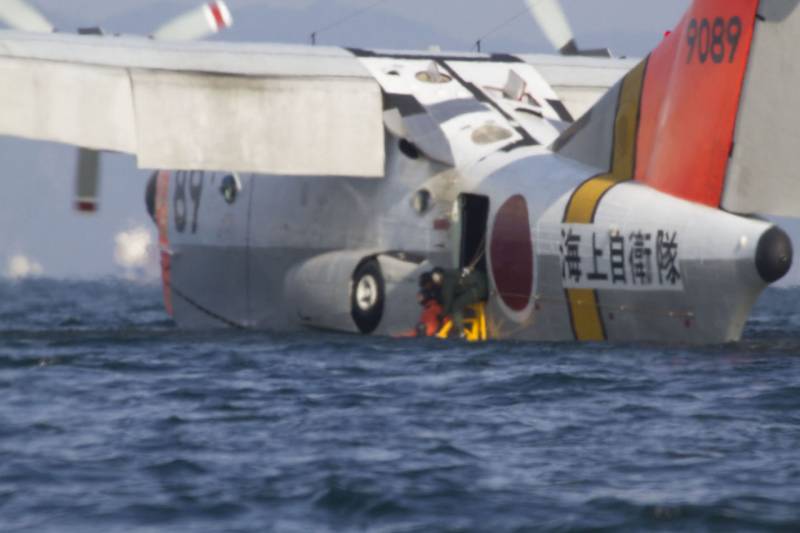
The crew of the US-1A aircraft assists the conditional casualty during the joint Japanese-American exercise, 8 in January, 2013. Photo by US Marine Corps / dvidshub.net
The first six US-1 aircraft were built according to the original project, but then a decision was made to modernize the equipment. Starting with the seventh car, the serial models were completed with T64-IHI-10J engines of increased power. Such a modification was designated as US-1A. From the mid-seventies, all new seaplanes were built on the project with the letter “A”. In addition, during scheduled repairs, the base US-1 was upgraded. As a result of this, by the early eighties only US-1A type equipment with an increased powerplant was in service.
According to known data, by the mid-eighties, Xing Maive built and transferred to the customer 12 aircraft, including the first “prototype”. The next order was received in the early nineties and provided for the construction of four more cars. 17-th US-1A was ordered and paid for in 1999 year. After that, new contracts for the production of such equipment were not concluded.
Already in the middle of July, 1976, just a couple of weeks after the start of service, the US-1 aircraft took part in a real search and rescue operation for the first time. In 350 miles from the Japanese coast was a Greek ship, from which it was necessary to urgently take the wounded sailor. The crew successfully coped with the task and in the minimum time took the victim to the hospital. In the future, this work continued.
Like the base PS-1, the new US-1 search and rescue aircraft was considered as a base for other types of equipment. First of all, the designers headed by S. Kukihara developed a new version of the fire seaplane. With the assistance of Canadian experts, they created a set of special equipment that allowed them to take on board 15 tons of water. Tanks could be refilled using special intaking devices directly while driving through water. Discharge was carried out through the tailpipes in the minimum time.
Also, the available volumes inside the fuselage could be used to accommodate passenger seats. Such a modification of a flying boat could carry from 40 to 60 passengers, depending on the configuration of the cabin. However, the fire and passenger modifications did not find their customers. Work on them was discontinued.
In operation, the serial US-1 used a curious approach. The naval self-defense forces kept no more than 7-8 aircraft in service at the same time. The rest of the cars at this time could undergo repairs or be involved in other tasks. At the same time, rotation and replacement of some amphibians by others ensured constant duty. Aircraft at any time could fly to the disaster area and assist the victims. As it became clear later, similar approaches to operation fully justified themselves and allowed us to obtain the desired work efficiency.
In 1999, the Maritime Self-Defense Forces Command reported that over the entire period of operation, US-1A aircraft took part in more than 500 search and rescue operations. Over 850 people were evacuated. High flight performance allowed the machines to work at a long distance from the Japanese islands, which also had a positive impact on the efficiency of their operation and on the fate of those in distress. Long work of search and rescue aircraft received the highest marks.
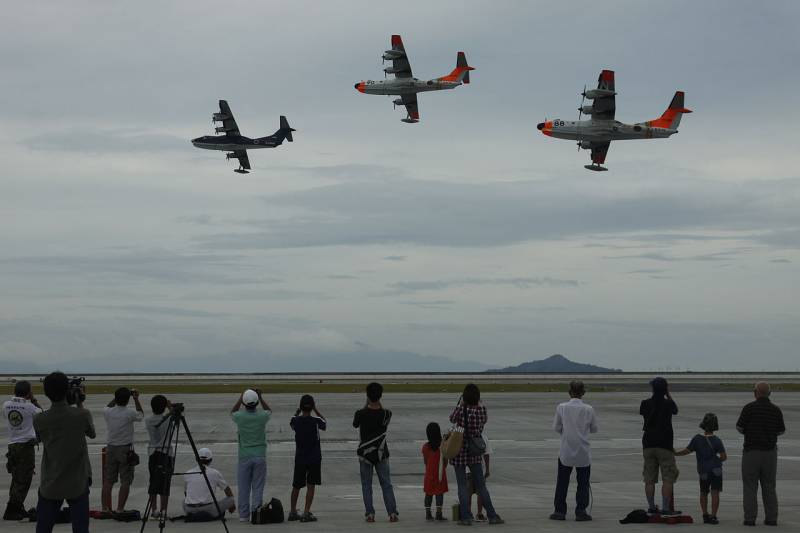
Generation Continuity: US-2 flying boats (left) and US-1A (center and right) participate in demonstration flights based on Iwakuni, September 18 2011. Photo by US Marine Corps / marines.mil
In general, the US-1A Sin Maive planes arranged for the operator, but over time it became necessary to create a new technology of a similar purpose. In the mid-nineties, the developer of anti-submarine and search and rescue vehicles received an order to create a new seaplane. A few years later, a prototype of the US-1A "Kai" took off. To date, such equipment has been adopted and is used under the name of US-2.
The launch of the production of amphibians allowed to start the program to write off existing equipment. US-1A, gradually developing their resource, were removed from service. The last car of this type finished the service quite recently - in December last year. Several decommissioned flying boats became museum exhibits, while others should be sent for disassembly.
The Japanese Self-Defense Forces received about two dozen US-1 and US-1A search and rescue seaplanes from the Xing Maive company. The operation of this technology lasted more than 40 years. During this time, the aircraft of two models took part in hundreds of real operations and saved hundreds of lives. Not so long ago, outdated aircraft gave way to new technology. Will the current US-2 repeat the successes of its predecessors - time will tell.
On the materials of the sites:
http://airwar.ru/
http://aviadejavu.ru/
http://mod.go.jp/
https://militaryfactory.com/
https://airspacemag.com/
http://airvectors.net/
http://nvo.ng.ru/
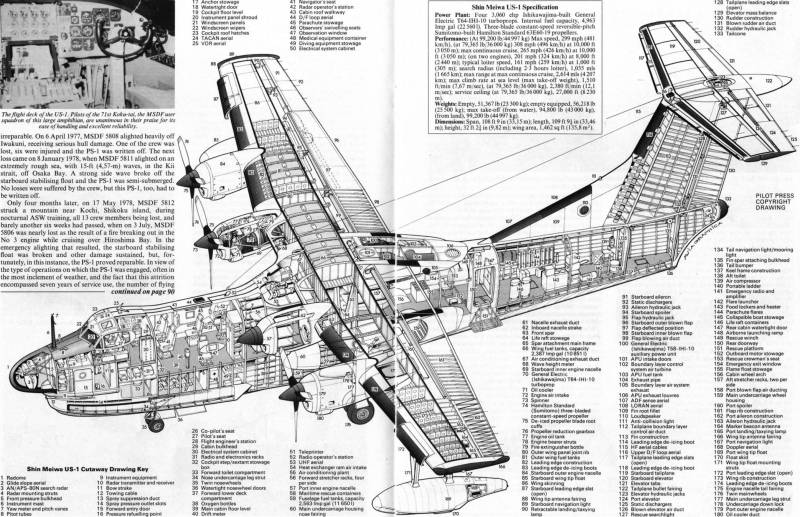
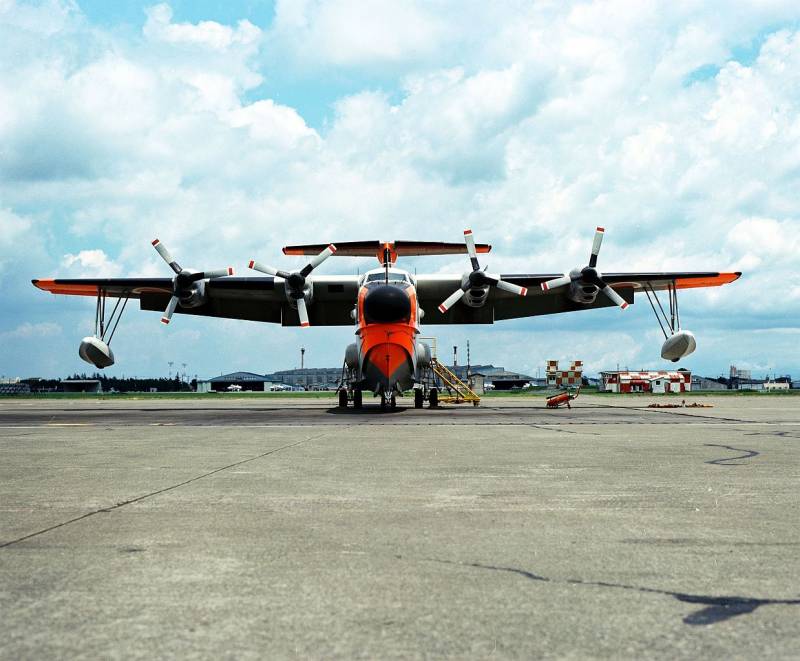
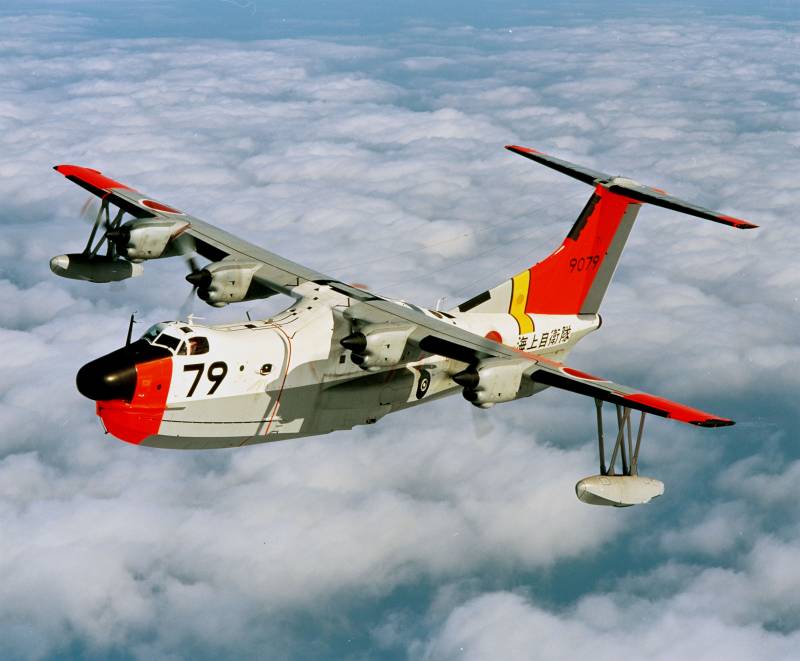
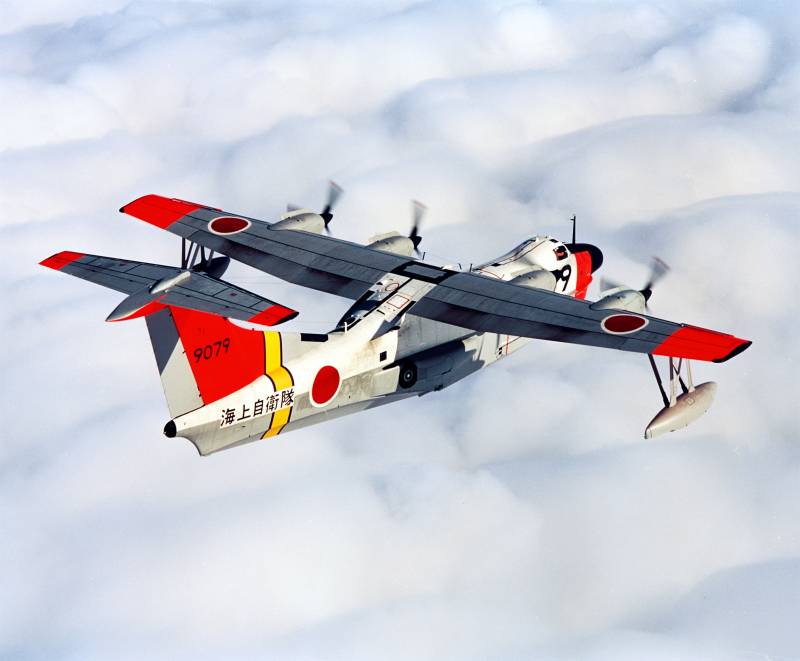
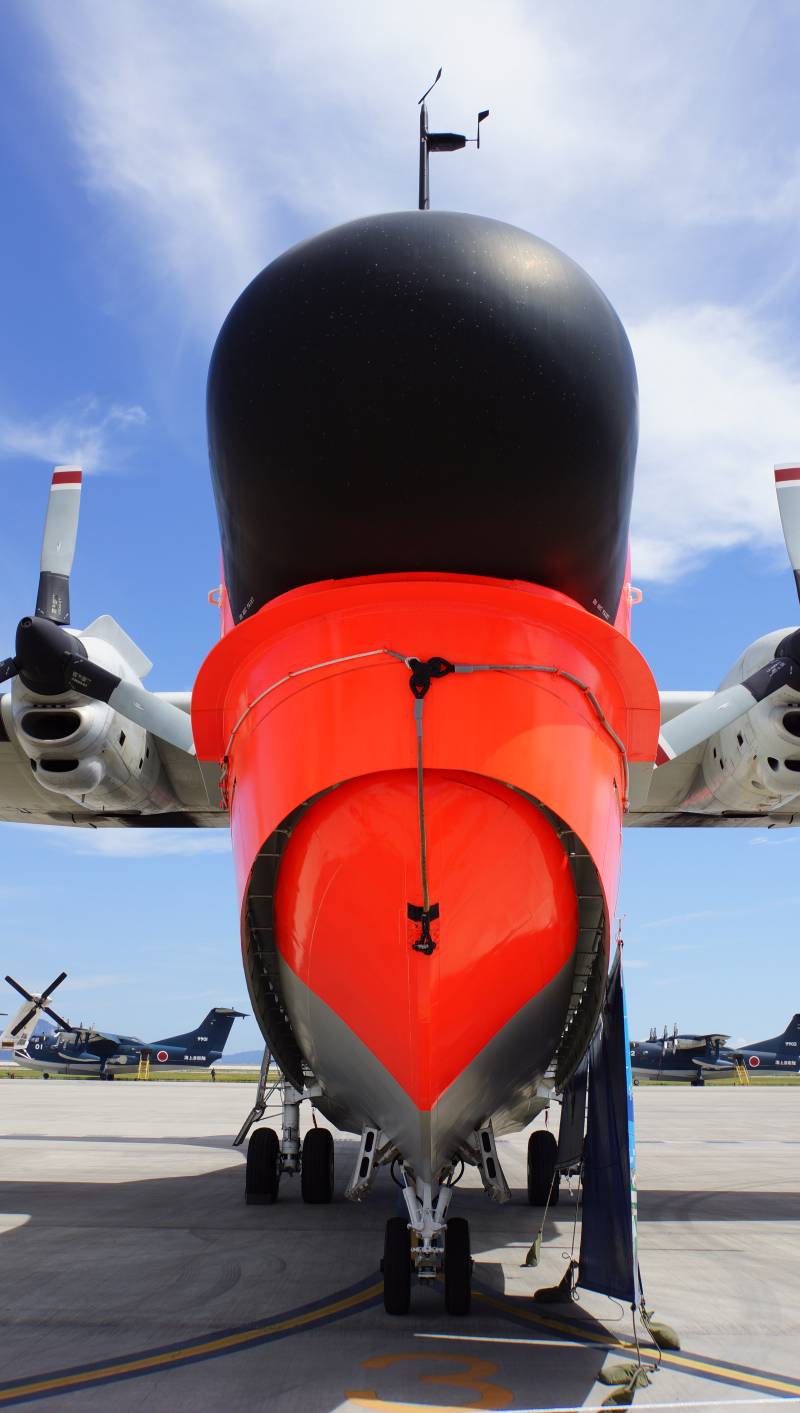
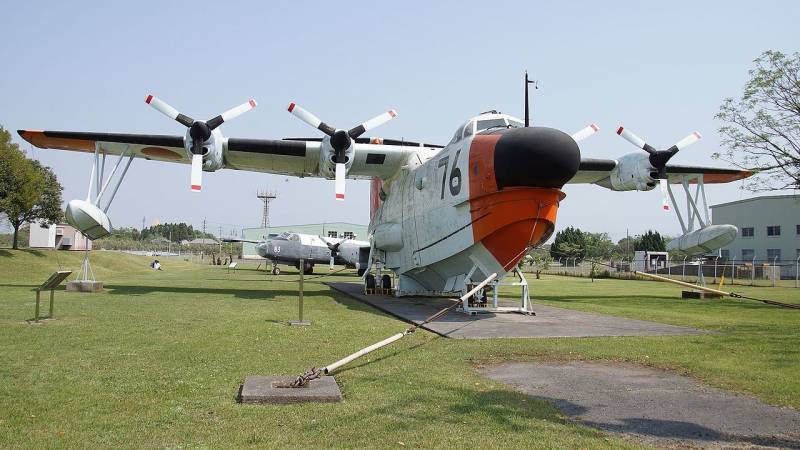
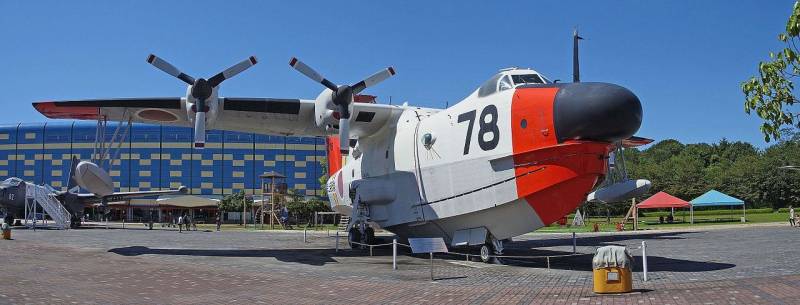
Information